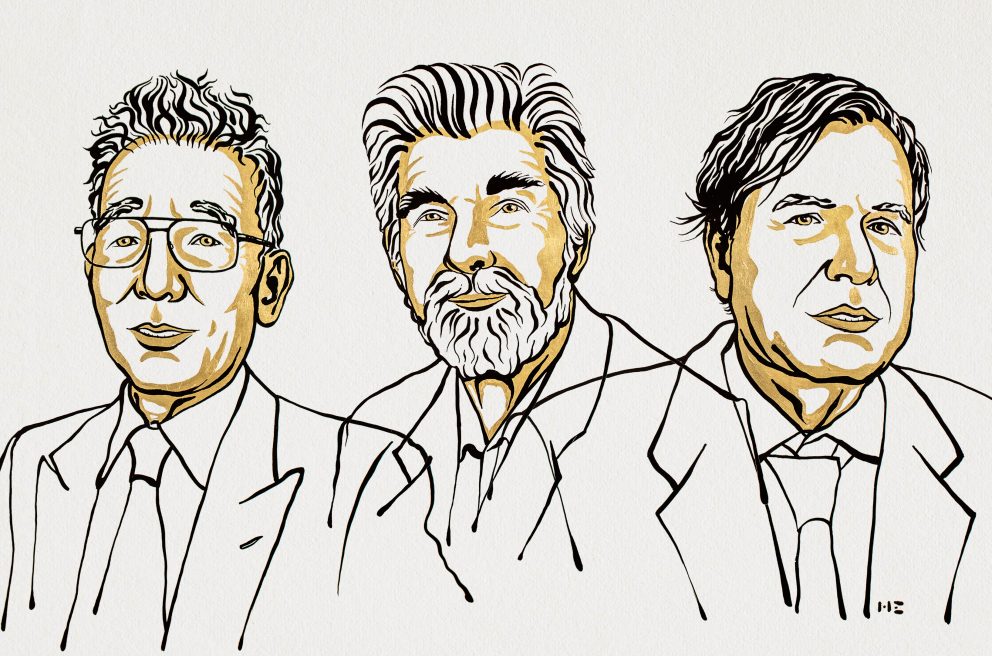Modelling the complexity of nature. Prof. Nowak on Nobel Prize
The Nobel week is underway. The Nobel Prizes in Physics were awarded to Syukuro Manabe, Klaus Hasselmann and Giorgio Parisi. Prof. Wiesław Nowak from the Department of Biophysics at the NCU Faculty of Physics, Astronomy and Informatics explains the complexities of this year's laureates' research interests.
The Royal Swedish Academy of Sciences has decided to honour three scientists for "groundbreaking contributions to our understanding of complex physical systems". Half of the award will be split between Syukuro Manabe from Princton University in the US and Klaus Hasselmann from the Max Planck Institute for Meteorology in Hamburg, Germany. The other half was awarded to Giorgio Parisi of Sapienza University in Rome. The researchers were recognised for developing the basis of models that can predict climate change and understand random processes.
- The discoveries recognised this year show that our knowledge of climate has a solid scientific foundation, based on careful analysis of observations. All of this year's laureates have contributed to gaining deeper insights into the properties and evolution of complex physical systems - said Thors Hans Hansson, Chairman of the Nobel Committee for Physics, when announcing the results.
Physical empire
- If we look at their research and publications, we can say that only Giorgio Parisi is a "true" physicist, while the other two can be classified as being rather on the borderline of this science: Syukuro Manabe deals with climate, and Klaus Hasselmann is scientifically interested in the oceans; they refer to themselves as "climatologist" and "oceanographer". However, this is a superficial and misleading view - says prof. dr habil. Wiesław Nowak from the Department of Biophysics at the NCU Faculty of Physics, Astronomy and Informatics.

All of the laureates have a thorough education in physics. All three also draw deeply on the achievements of physics, mathematics and mathematical physics in their research.
I always tell my students that physics is eminently imperialistic - after all, it covers almost every area of life, and all natural sciences are essentially based on it - says Prof. Nowak. - Although they are physicists, the laureates can be classified as interdisciplinary researchers. This was also pointed out by the Academy - it showed that achievements and research of this year's Nobel Prize winners are applicable in many other fields and disciplines.
Butterfly effect and research by the remarkable Italian
Giorgio Parisi was awarded the Nobel Prize "for his discovery of the interplay of disorder and fluctuations in physical systems from atomic to planetary scales". His research may be difficult to understand by a layperson - the Italian scientist has devoted almost his entire professional life to the study of disordered phenomena in complex systems.
In order to realise the difference between complex and non-complex systems, we can use the example of a drop of water - explains Prof. Nowak. - Let us imagine that we are looking at it from a distance: we do not know whether it is pure or dirty water, whether it contains bacteria, for example. Of course, we can determine its basic physical parameters, such as weight or diameter. We can also try to describe its movement - e.g. on a table or glass, using the simplest model and treating it as a material point. Such a drop is not complicated, so we are dealing with a non-complex system.
Let us go a step further - suggests Prof. Nowak - and imagine a huge collection of blobs: the ocean. One can, of course, look at it as a single object and analyse it in this way. A second approach, however, proposes to treat the ocean as a complex system, consisting precisely of an enormous number of drops. The droplets behave collectively, interacting both with each other and with their surroundings, such as the wind.
- The behaviour of a droplet, its motion and dynamics, is dictated by the laws of Newtonian physics. However, there may also be more subtle effects that ordinary Newtonian physics cannot explain. This is due to the fact that there are so many drops, so complexity appears - says Prof. Nowak. - A complex system, containing disordered and random elements, may have its own physics. It is extremely difficult to describe it, especially if there are also phenomena that are non-linear, based on the amplification of something, e.g. drops are subjected to coupling with a complex environment. Strange structures such as waves can then appear in the ocean.
Parisi applied mathematical models to such problems. He studied symmetry breaking in certain systems, such as spin glasses. In 1980, he discovered repetitive patterns in complex systems that allow us to understand seemingly random phenomena. The results of his work are used not only in physics, but also in mathematics, biology, programming of artificial intelligence systems and medicine. At one time, he even studied the immune system, which he approached as a complex system.
The model of description he introduced is so advanced that it can be applied analogically to many other situations in which something occurs that may be associated with chaos - explains Prof. Nowak. - And this is where an explanation is necessary: commonly we think that chaos is just a mess, disorder, something bad and incomprehensible. In physics, however, chaos has a slightly different meaning. Let us return to our drop of water. Let's imagine it again, this time on the edge of a table. If we slightly change the initial conditions of its movement, we will either move it in the direction of the table, on which it will roll, or - directing it in the opposite direction - it will fall, break on the floor and split into many smaller droplets. Before we act on it, it is in a state of unstable equilibrium. Chaotic systems are characterised by what we call the "butterfly effect", i.e., a minimal change in boundary conditions can cause dramatically large effects.
Prof. Nowak is not afraid to call Parisi a genius. His scientific achievements bring us closer to the description of phenomena that physics is currently unable to describe.
- There are such phenomena surrounding us that not only do we not know how to solve equations, but we don't even know how to write them - says Prof. Nowak. - Staying with the water theme: a common wood pigeon somewhere on top of a wave on the Baltic Sea is practically indescribable at the moment. We know that it is governed by physics, but we don't know the physics of such a complex system, how to predict its behaviour as a function of time. Parisi sees reality more broadly, looking all the time with the eye of a physicist. His contribution is absolutely valuable to the work of many scientists in various fields, not only physics.
Modelling the Earth's climate
Some of Parisi's equations can be successfully applied to the difficult problem of predicting weather and climate change. His work thus has elements in common with two subsequent Nobel laureates in physics (although they personally never collaborated, conducted research or published).
Syukuro Manabe and Klauss Hasselmann received the Nobel for "the physical modelling of the Earth's climate, quantifying variability and reliably predicting global warming".
- Both figures are extremely interesting - says Prof. Nowak. - Professor Manabe, a creative and very imaginative scientist, started by developing a mathematical model of the atmosphere. He came all the way to demonstrate in 1967 how increased levels of carbon dioxide in the atmosphere led to an increase in the Earth's surface temperature.
He was the first scientist to study the interaction between radiation balance and vertical transport of air masses. His work laid the foundation for the development of current climate models. He is greatly credited with the mathematical modelling of atmospheric phenomena.
I have the impression that the key figure among the three laureates is Klauss Hasselmann, that this year's entire Nobel Prize was "built up" around his scientific achievements - says Prof. Nowak. - Hasselmann initially dealt with turbulence phenomena, then he began to be interested in sea waves.
The German physicist tried to explain where waves come from and why they were the way we see them, whether any regularities could be observed.
- He measured waves, checked the distances between their crests, and related this to wind power and meteorological phenomena. He made a great contribution to introducing models to explain wave formation - says Prof. Nowak. - One of his merits in this field is indicating that the observed waves are connected with non-linear phenomena: we are dealing with the simulation of small fluctuations causing a big effect.
Professor Nowak compares this situation to playing with a child on a swing. The standing parent pushes the child with a little force in the back, and after a while the child swings very high up.
- It is resonance excitation - you must know when and where to push the child. It turned out that it is similar with waves: small phenomena fluctuate, accumulating energy and lead to the creation of a huge force, i.e., a huge ocean wave, which arose, for example, on the coast of Australia and reached as far as Greenland. These phenomena manifest the so-called stochastic resonance - says Prof. Nowak.
He conducted his research on Hawaii, then took it to Europe on a large scale, focusing on the North Sea.
Hasselmann's experiments were used to create a mathematical model of the oceans - to show how currents flow, how energy is transferred and how this interacts with climate. The data he collected also indicate that this non-linear phenomenon also occurs in nature - says Prof. Nowak.
Hasselmann initiated a programme to assess the behaviour of the climate, without taking into account anthropomorphic effects. Why?
- Because the climate is not constant, it also fluctuates. This allowed us to create a model showing how these fluctuations, when they accumulate, can lead to long-term, that is, long-lasting or even centuries-long changes in the climate, which are natural - says Prof. Nowak. - The CO2 cycle was added to this, and the physical effects of such a process were shown. So, you could clearly see the greenhouse effect: thanks to Hasselmann's models, it was easy to see which climate changes were occurring, or would occur, naturally, and which were caused by a human factor. This triggered a huge current of climate research. The work of this year's Nobel laureates has a practical aspect - it has contributed to better computer models for weather forecasting.
 NCU News
NCU News






 Exact sciences
Exact sciences

 Exact sciences
Exact sciences